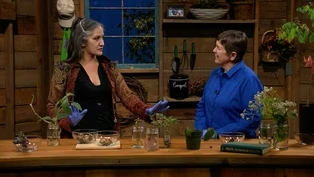Virginia Home Grown
What is inside a pitcher plant?
Clip: Season 25 Episode 8 | 5m 56sVideo has Closed Captions
Discover how many insects pitcher plants catch.
Dr. Phil Sheridan from the Meadowview Biological Research Station visits the studio to talk with Peggy about bog plants and dissect a pitcher plant to see how many insects it can trap. Featured on VHG episode 2508, October 2025.
Problems playing video? | Closed Captioning Feedback
Problems playing video? | Closed Captioning Feedback
Virginia Home Grown is a local public television program presented by VPM
Virginia Home Grown
What is inside a pitcher plant?
Clip: Season 25 Episode 8 | 5m 56sVideo has Closed Captions
Dr. Phil Sheridan from the Meadowview Biological Research Station visits the studio to talk with Peggy about bog plants and dissect a pitcher plant to see how many insects it can trap. Featured on VHG episode 2508, October 2025.
Problems playing video? | Closed Captioning Feedback
How to Watch Virginia Home Grown
Virginia Home Grown is available to stream on pbs.org and the free PBS App, available on iPhone, Apple TV, Android TV, Android smartphones, Amazon Fire TV, Amazon Fire Tablet, Roku, Samsung Smart TV, and Vizio.
Providing Support for PBS.org
Learn Moreabout PBS online sponsorshipSo, Dr.
Phil, I know what you've brought is, I'll say, limited in scale, but understand some of this is extremely ancient and old.
So, please, share with us.
>>Sure.
Well, Peggy, let's start with, we talked about bioindicators just a minute ago, and so one of the questions I frequently get from people is how to know where a pitcher plant habitat would be, and the first thing I tell 'em is to look for sphagnum moss.
So, there are a number of species of sphagnum moss.
This is one of our red species here.
You actually identify 'em on their characteristics.
They're beautiful.
They're called biological indicators because they tell us the soil is constantly moist, it's acidic, it's the right pH, and it's high water quality.
So, right away, without any complex tools, I can see this plant and it tells me right away I've got the right habitat, potentially, for pitcher plants and its rare associates.
>>Interesting.
How long has sphagnum moss been on, I'll say, the face of the earth here?
>>I don't know.
>>Millions of years?
>>Million of years, for sure.
Yeah, the mosses have been around a long time.
>>Yes, yes, it's just interesting people don't realize that we're saying sphagnum moss, but it takes so long to create a stand and then to have the pitcher plant come in.
>>That's right, and actually, so peat mosses are the basis for Northern peat bogs, for example, or the sphagnum peat that you get at the nursery center is actually decomposed sphagnum moss and other plants from Northern peat bogs.
>>Interesting.
>>So, we've got our red variety here, one species.
We've got the green variety, which is another species.
We've got compacts, types of sphagnum that are quite expensive now that we offer 'cause there's a lot of interest in very tight sphagnum mosses.
So, there's a whole sub-market with sphagnum moss.
>>Interesting, mix the textures and make a terrarium.
>>Yeah, and we have the perfect Christmas colors, red and green, right?
>>Exactly.
>>Getting ready for the holiday season.
>>Yes, we are.
>>And then we get into the fun stuff.
>>Oh, exactly.
Let's talk about these Sarracenias or pitcher plants.
>>Okay, yeah.
So, this is, when you came up to Meadowview, you saw the white-topped pitcher plant, and it's one of our most attractive pitcher plants.
>>It's beautiful, yes.
>>And it catches a lot of insects this time of year.
This is the real crowd-pleaser.
>>Okay.
>>People like to see, I'm gonna do a dissection.
Do I have your permission to do that on TV?
>>You have my permission to do it on TV.
>>So, we already talked about how insects are captured by or are attracted by nectar and scent, and some of the insects fall in.
There's the escape hatch where some of the insects got out, but if we do, you get a sharp knife and go down the leaf like this.
>>And this is a leaf, it's not the flower.
I think you need to keep that in mind.
>>I am going down.
>>And we're going down.
>>Down, down, down.
>>Imagine that bumblebee falling in.
>>And it gets tighter and tighter, and there's downward-pointing hairs here too that capture the insect.
>>Oh, to get it trapped down there, huh?
>>Yeah, and here we go.
Oh, there we go.
>>Oh, my!
>>Look at that.
>>Look at what we have here.
>>So, that's just in a few days, and we have so many pitcher plants, there may not even be enough insects this time of year at Meadowview.
I mean, with thousands of pitcher plants, they're actually capturing quite a few insects.
Sometimes the white tops will totally fill up.
>>Well, say, unlike the purple pitcher plant, this is a dry capture.
>>Pretty much, yeah, that's right.
Do you wanna do another leaf for giggles?
>>Yeah, just for the fun.
Let's see what's in this one.
>>Let's go for pink.
>>Let's do the pink, beautiful as well.
>>Yeah, that's a lovely, lovely leaf.
>>How can people enjoy these at home, or should they just come to the Preserve and enjoy 'em there?
>>Well, they can enjoy 'em at home in a bog garden that they can build.
We recommend just growing 'em as container gardens.
>>Okay.
>>Container bog gardens, and we sell over the internet, so they don't even have to visit.
They can conveniently order off the online shopping cart.
>>Interesting.
>>And we'll ship.
>>Interesting.
>>Through priority mail.
Wow!
For Christmas!
(Peggy laughing) (chuckles) Whoa!
>>Whoa!
You hit the jackpot.
>>I hit the mother lode.
So, here we've got, now think about that.
Think about all the nutrients that you're gonna get, or this plant's gonna get, from these insects.
And here's another interesting part of the ecology here, Peggy, that a lot of people don't think about.
When fire rolls through this ecosystem, because these are fire-maintained ecosystems, leaves that haven't fallen apart, when the fire comes through- >>Oh, there goes a fly.
>>And burns up the leaves, these nutrients are deposited around the pitcher plant as ash and actually fertilize the plant itself and pitcher plant seedling.
So, that's one way that the nutrients quickly are moved from the plant to the actual soil column.
>>Interesting.
We forget the important role fire plays.
>>Fire's very important.
>>Yes.
>>And then, let's not forget the hatpins.
>>I love these.
>>They're another bog plant, but if you were to use these for flower decorations, you could even put some hatpins in there, and if you have a whole bunch of 'em, they're fun to knock around like that.
>>They certainly are.
They add a little motion to just about anything, even to the breeze, you know?
But it's interesting, these plants, we don't think of them as, you know, I wanna say, things that we can relate to, and they're actually rhizomes, you know, just like our irises are, the way they grow with underground stems.
>>Underground stems.
That's right, that's great.
>>But the habitat is so different that they can't, of course, survive in our gardens at all 'cause of the soil.
It could be too nutrient-rich.
>>In a conventional garden.
>>Yeah.
>>That's correct.
Now you could build a bog garden.
I mean, it's possible to build a bog garden to grow the plants more than I'm gonna get into here.
I really think just growing 'em as container gardens is much simpler and a lot less work.
>>Sounds like a good plan, and also to understand the number of insects that they capture, and that just wasn't one or two.
That was a lot of insects in there.
>>That's right.
>>Yes, and for them to be able to process this, for them to get their proteins and other nutrients for their life processes to continue on, it's fascinating, Dr.
Phil.
And I really do appreciate you sharing this all with us 'cause it's something that we've all wondered about.
It's a little mysterious, and now you've settled a lot of questions.
>>You bet, Peggy.
>>Yes, thank you.
Video has Closed Captions
Clip: S25 Ep8 | 26m 46s | Explore the world of deadly plants to discover their benefits! (26m 46s)
Video has Closed Captions
Clip: S25 Ep8 | 8m 5s | Discover Virginia’s native carnivorous plant! (8m 5s)
Plants that can be Toxic to Pets
Video has Closed Captions
Clip: S25 Ep8 | 7m 36s | Learn about common and uncommon plants with toxic properties (7m 36s)
Video has Closed Captions
Clip: S25 Ep8 | 7m 30s | Learn how to identify poisonous plants (7m 30s)
Video has Closed Captions
Clip: S25 Ep8 | 3m 31s | Learn how to grow Venus flytraps at home (3m 31s)
When Tomatoes were Considered Poisonous
Video has Closed Captions
Clip: S25 Ep8 | 2m 44s | Discover why tomatoes did not catch on in Europe for hundreds of years (2m 44s)
Providing Support for PBS.org
Learn Moreabout PBS online sponsorship

- Home and How To

Hit the road in a classic car for a tour through Great Britain with two antiques experts.












Support for PBS provided by:
Virginia Home Grown is a local public television program presented by VPM






